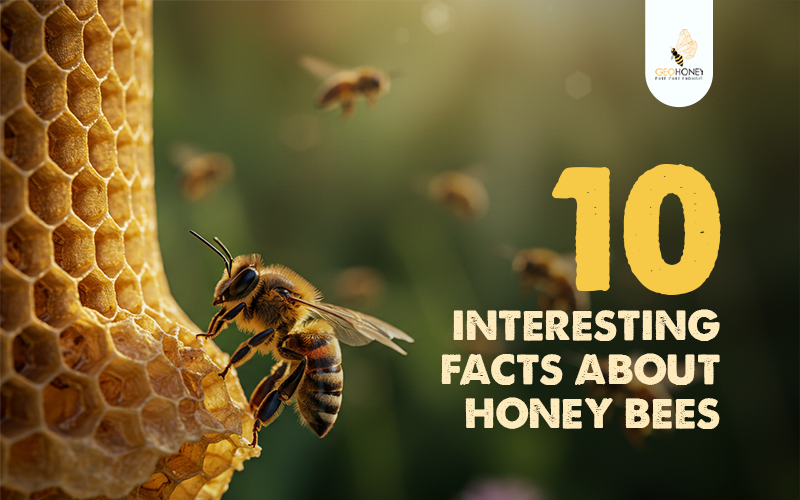- Tokyo: 00:15
- Singapore: 23:15
- Dubai: 19:15
- London: 15:15
- New York: 10:15
10 interesting facts about honey bees

Honey bees are indispensable to the global ecosystem and food supply. These hardworking creatures not only give you valuable commodities like honey, beeswax, and royal jelly but are also responsible for pollinating about 90% of wild plants.
“Honey bees are truly an impressive keystone species that influence the planet and its entire ecosystem both directly and indirectly.”, says the founder of Geohoney and the CEO of BA Barry Group, Mr. Basem Barry.
There are so many unique aspects to these incredible creatures that one can not cover them all in a short time. This blog lists some of the most interesting facts about bees that set them apart from the rest of the pollinators and insects.
These unique facts will help you realize what makes honey bees so special and extremely valuable for every being on the planet, so, keep on reading till the end.
Bees are Found Everywhere Except Antarctica
Honey Bees Communicate by Dancing
Honey Bees Posses Five Eyes
Different Honey Bees Have Different Roles Inside a Hive
Honey Bees Sleep 5 to 8 Hours a Day
Honey Bees Can Fly Very Far and Very Fast
Honey Bees Can See Ultraviolet Light
Queen Bee can Live for Up to 5 Years
Honey Bees Possess 170 Odorant Receptors
Honey Bees Can Recognize Human Faces
Bees are Found Everywhere Except Antarctica
Bees are extremely diverse pollinators that are found in almost every continent. There are about 20,000 known species of honey bees at the moment that you can find in a wide variety of habitats from arid deserts to extremely cold polar regions.
The only region where honey bees don’t exist is the continent of Antarctica which has extremely difficult living conditions for any organism to thrive.
These resilient creatures have undergone 120 million years of evolution which has enabled them to adapt to extremely harsh surroundings.
Honey Bees Communicate by Dancing
Honey bees perform different types of dances to communicate with their hives and other bees. They do a waggle dance to indicate the direction of a nectar source that is far away. Bees also dance around in circles which shows a floral source is nearby.
There is another dance called the Tremble Dance that bees do to communicate the fact that the foragers need to stop bringing in more nectar as there are not enough bees inside the hives to process it.
This dance urges them to recruit more bees for processing incoming nectar which optimizes organic honey processing inside the hive.
Honey Bees Posses Five Eyes
Honey bees possess a total of five eyes. This fascinating honey bee biology makes them extremely productive pollinators.
Two of these eyes are larger compound eyes while the remaining three are smaller or simpler eyes in the center of their heads. The two compound eyes feature numerous lenses which allow them to look in multiple directions.
These eyes are more receptive to blue and ultraviolet light. This allows them to detect floral sources that reflect ultraviolet light as they appear very bright to their senses.
The smaller eyes give them the ability to differentiate colors and their intensities which improves navigation. These eyes also allow bees to maintain stability in their flight.
Different Honey Bees Have Different Roles Inside a Hive
Every honey bee has a very special role to play in a bee colony. At the top of the chain are the Queen Bees who run the hive using their “Queen’s Substance” pheromone. These bees mate with drones, lay eggs, and control the behaviors of other members of the hive.
Workers are female bees that forage pollen, build the hive, feed the brood, prepare raw honey, attend to the queen, and raise newer queens.
The job of male drone bees is to mate with the queen. Hundreds of drone bees live in the hive during summer and spring. However, these bees are kicked out of the hive as soon as the winter comes.
Honey Bees Sleep 5 to 8 Hours a Day
Bees sleep for 5 to 8 hours at night when they are done with collecting nectar. During this time, a bee will start to flex its legs and bring its head to the floor of the hive. The wings and the antennae of the bee stop moving and, in some cases, they fall over sideways while in the sleeping state. Bees can also sleep in the center of flowers if they find the conditions safe.
Honey Bees Can Fly Very Far and Very Fast
Honey bees can travel long distances and return back to the hive safely. These creatures can fly as far as 5 miles for food. Bees can fly at a speed of 15 to 20 miles per hour when moving towards the source of nectar.
After collecting nectar or pollen, bees return to the hive at an astonishing speed of 12 miles per hour on average. Another remarkable fact is that a bee can flap its wings about 200 times every second which is what gives them this high speed.
Honey Bees Can See Ultraviolet Light
Unlike humans who can only see 7 colors found in the visible spectrum, honeybees can also see ultraviolet light. This ability of the bee allows them to find suitable nectar and pollen sources to make the highest quality monofloral honey and to keep the whole hive well-fed.
Queen Bee can Live for Up to 5 Years
Next up on our list of amazing facts about honey bees is the fact that a queen honey bee can live up to 5 years under normal conditions. During this time the queen lays about 2000 to 2500 eggs.
In comparison, drone bees can only live for about two months and the workers can last anywhere from six weeks to six months.
Honey Bees Possess 170 Odorant Receptors
Another amazing feature of honey bees is their large number of odorant receptors. This means the bees have an incredible sense of smell which is sensitive to even the lightest odors.
These receptors help honey bees find nearby floral sources and determine whether they are good enough or not.
Honey Bees Can Recognize Human Faces
Honeybees can also recognize and differentiate between human faces. The compound eyes of the bees detect a person’s facial features like the shape of their eyes, ears, and nose.
Bees can not only recognize faces but also keep this information stored even after several days of the interaction.
Conclusion
Honey bees are really complex, interesting, and smart creatures that have baffled researchers for years. These incredible insects possess discipline, intelligence, and a community-based lifestyle where every member is given a specific role to play.
However, honey bees are facing many dangers like habitat loss and a decline in population which are mainly caused by climate change, the use of pesticides, and some harmful human activities.
However, these resilient creatures are still trying their best to survive, provide us with food, and prepare the golden elixir called honey that we all adore so much.
As scientists look more closely into the lifestyle and habits of honey bees, newer and more interesting information is coming to light which shows there is still so much we do not know about bees.
You can visit us at Geohoney to learn more about bees and to order our top-quality pure monofloral honey that offers the best taste and numerous health benefits.




Absolutely! 🐝 Bees are amazing creatures — not just for their honey, but for their complex behavior, intelligence, and role in our environment.